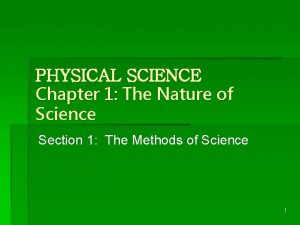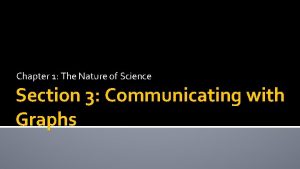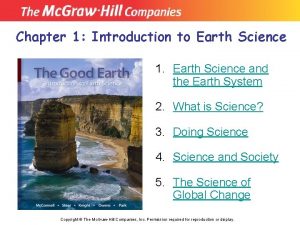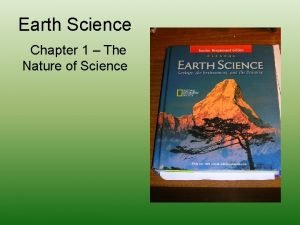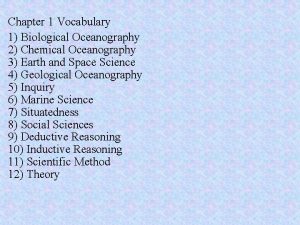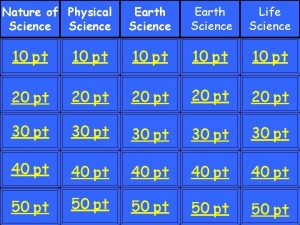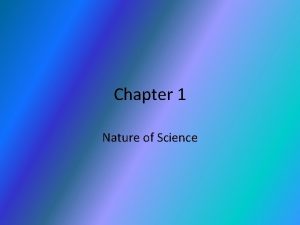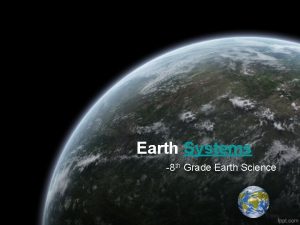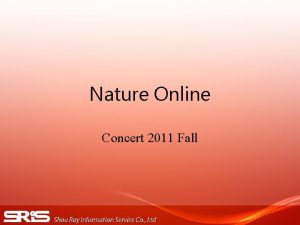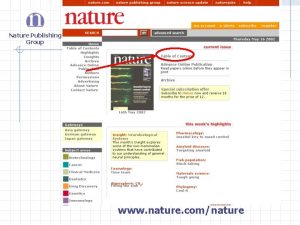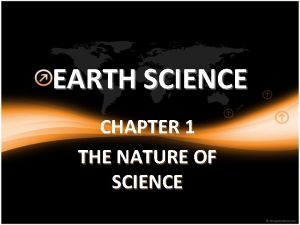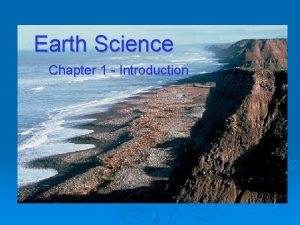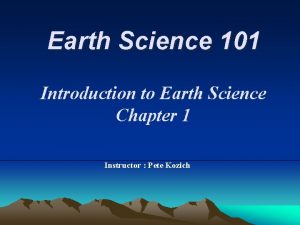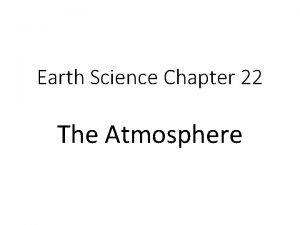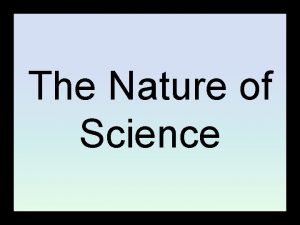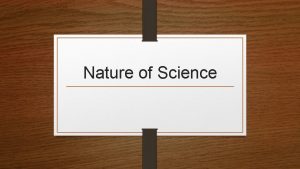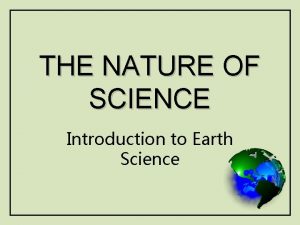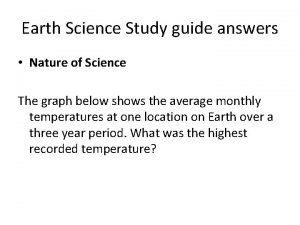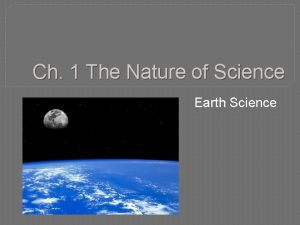Earth Science Chapter 1 The Nature of Science



























- Slides: 27

Earth Science Chapter 1 – The Nature of Science

Earth Science OBJECTIVES Differentiate among the four major branches of Earth Science. Contrast the four systems of Earth. Discuss how Earth science effects your daily life.

Chapter 1 – Major Areas There are four major areas in Earth science. Astronomy is the study of objects beyond the Earth’s atmosphere. M 101 is a large Milky-Way -like galaxy in Ursa Major, about 25 million light-years (ly) distant.

Chapter 1 – Major Areas (continued) The study of the materials that make up Earth and the processes that form and change these materials is known as geology.

Chapter 1 – Major Areas (continued) The study of Earth’s Oceans is called oceanography. The following activities are usually performed by oceanographers: studying the creatures that inhabit salty water measuring physical and chemical properties of the oceans examining the effects of human activities on Earth's saltwater bodies

Chapter 1 – Major Areas (continued) Meteorology is the branch of Earth science that deals with Earth’s atmosphere.

Chapter 1 Spheres Earth can be divided into four major systems (or spheres). The lithosphere includes the rocks that make up the crust and rigid upper mantle.

Chapter 1 Spheres – continued The atmosphere is the blanket of gas that surrounds Earth.

Chapter 1 Spheres - continued Earth’s hydrosphere is the system of all of the water on the planet. The water in Earth’s oceans, seas, lakes, rivers, glaciers, and in Earth’s atmosphere makes up the hydrosphere.

Chapter 1 Spheres - continued The biosphere is Earth’s inhabitants and their environments.

Earth’s four main systems interact with one another. • You are part of the biosphere. • You live on the crust, which is part of the lithosphere. • You breathe gases in the atmosphere. • You depend in many ways on the water in the hydrosphere. Chapter 1 The Spheres – the Summary

1. 2 Methods of Scientists OBJECTIVES List the steps used in a scientific method. Compare and Contrast experimental variables and controls. Identify basic SI units. Explain how to write numbers using scientific notation.

Chapter 1 Section 2 The first step in a scientific method is to identify the problem and determine what you want to know. • defining the problem, • stating a hypothesis • analyzing the results of the test • and drawing conclusions.

Comparing & Contrasting the independent variable and the dependent variable. Independent variable Dependent variable Both variables are involved in scientific experimentation. An independent variable is a factor that can be manipulated. The x-axis. A dependent variable is a factor that results from manipulating the independent variable, and is measured by the experimenter. The y-axis

Control To show that the results of the experiment are actually due to the condition being tested, scientists use a control, which is a standard for comparison.

Chapter 1 Section 2 In scientific notation, a number is expressed as a value between 1 and 10 multiplied by a power of 10. 525, 600 Minutes 0. 001 M 5. 256 x 105 Minutes 1. 0 x 10 -3 M

Chapter 1 Section 2 Most scientific studies use a standard system of units called SI (Le Systeme International d'Unites ), which is a modern version of the metric system.

SI Le Systeme International d'Unites The SI unit of mass is kilogram (kg). Mass gram

SI Length meter Le Systeme International d'Unites Temperature Kelvin

SI Time second Le Systeme International d'Unites Liquid equivalent liter

SI Weight Newton Le Systeme International d'Unites

1. 3 Communicating in Science OBJECTIVES List several ways in which scientific information is communicated. Differentiate between a scientific theory and a scientific law.

Chapter 1 Section 3 Scientific information is communicated through: • lab reports, • professional papers. either of which may include tables and graphs, and models.

Chapter 1 Section 3 A basic fact that describes the behavior of a natural phenomenon is called a scientific law. May be thought of as a ‘rule of nature’, even though the cause of the law may not be known.

Chapter 1 Section 3 Scientific theory is based on an explanation which is based on many observations during repeated experiments.

Chapter 1 Section 3 A scientific theory is valid only if: • it is consistent with observations, • makes predictions that can be tested, and • is the simplest explanation of observations.

Chapter 1 Section 3 A theory can be changed or modified if it is found to be incorrect.
 Nature of science chapter 1
Nature of science chapter 1 The nature of science chapter 1 section 3 answer key
The nature of science chapter 1 section 3 answer key Chapter 1 introduction to earth science
Chapter 1 introduction to earth science Chapter 1 the nature of science study guide answers
Chapter 1 the nature of science study guide answers Chemical oceanography definition
Chemical oceanography definition Nature and nature's law lay hid in night meaning
Nature and nature's law lay hid in night meaning Determinace lidské psychiky
Determinace lidské psychiky Titans burning wheels
Titans burning wheels What is your favourite subject in college and why
What is your favourite subject in college and why Hình ảnh bộ gõ cơ thể búng tay
Hình ảnh bộ gõ cơ thể búng tay Slidetodoc
Slidetodoc Bổ thể
Bổ thể Tỉ lệ cơ thể trẻ em
Tỉ lệ cơ thể trẻ em Voi kéo gỗ như thế nào
Voi kéo gỗ như thế nào Chụp phim tư thế worms-breton
Chụp phim tư thế worms-breton Chúa yêu trần thế alleluia
Chúa yêu trần thế alleluia Các môn thể thao bắt đầu bằng tiếng chạy
Các môn thể thao bắt đầu bằng tiếng chạy Thế nào là hệ số cao nhất
Thế nào là hệ số cao nhất Các châu lục và đại dương trên thế giới
Các châu lục và đại dương trên thế giới Công của trọng lực
Công của trọng lực Trời xanh đây là của chúng ta thể thơ
Trời xanh đây là của chúng ta thể thơ Cách giải mật thư tọa độ
Cách giải mật thư tọa độ 101012 bằng
101012 bằng độ dài liên kết
độ dài liên kết Các châu lục và đại dương trên thế giới
Các châu lục và đại dương trên thế giới Thể thơ truyền thống
Thể thơ truyền thống Quá trình desamine hóa có thể tạo ra
Quá trình desamine hóa có thể tạo ra Một số thể thơ truyền thống
Một số thể thơ truyền thống
